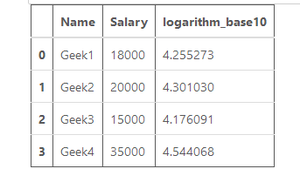Pandas 中列的对数和自然对数值 – Python
可以使用 pandas 中列的对数和自然对数值计算 log() 、 log2()和 日志10() numpy函数分别。在应用函数之前,我们需要创建一个数据框。
代码:
Python3
# Import required libraries
import pandas as pd
import numpy as np
# Dictionary
data = {
'Name': ['Geek1', 'Geek2',
'Geek3', 'Geek4'],
'Salary': [18000, 20000,
15000, 35000]}
# Create a dataframe
data = pd.DataFrame(data,
columns = ['Name',
'Salary'])
# Show the dataframe
dataPython3
# Calculate logarithm to base 2
# on 'Salary' column
data['logarithm_base2'] = np.log2(data['Salary'])
# Show the dataframe
dataPython3
# Calculate logarithm to
# base 10 on 'Salary' column
data['logarithm_base10'] = np.log10(data['Salary'])
# Show the dataframe
dataPython3
# Calculate natural logarithm on
# 'Salary' column
data['natural_log'] = np.log(data['Salary'])
# Show the dataframe
data输出:

pandas 列的以 2 为底的对数:
创建数据框后,我们可以将numpy.log2()函数应用于列。在这种情况下,我们将找到列工资的对数值。计算值存储在新列“logarithm_base2”中。
代码:
Python3
# Calculate logarithm to base 2
# on 'Salary' column
data['logarithm_base2'] = np.log2(data['Salary'])
# Show the dataframe
data
输出 :

pandas 中列的以 10 为底的对数:
要找到以 10 为底的值的对数,我们可以将numpy.log10()函数应用于列。在这种情况下,我们将找到列工资的对数值。计算值存储在新列“logarithm_base10”中。
代码:
Python3
# Calculate logarithm to
# base 10 on 'Salary' column
data['logarithm_base10'] = np.log10(data['Salary'])
# Show the dataframe
data
输出 :

pandas 中某列的自然对数值:
要找到自然对数值,我们可以将numpy.log()函数应用于列。在这种情况下,我们将找到列工资的自然对数值。计算值存储在新列“natural_log”中。
代码:
Python3
# Calculate natural logarithm on
# 'Salary' column
data['natural_log'] = np.log(data['Salary'])
# Show the dataframe
data
输出 :
